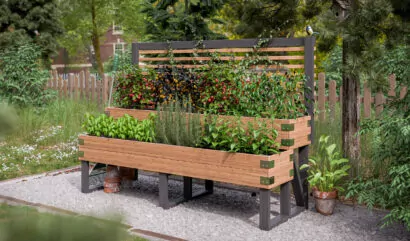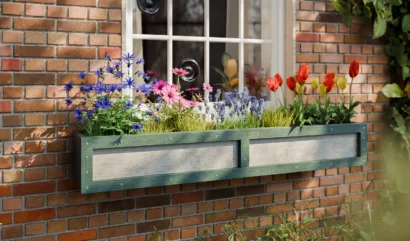Choosing Your Raised Garden Bed Plan: A Comprehensive Guide
Every inspiring garden space begins with selecting the right raised garden bed plan. In this guide, we’ll help you navigate the various options available and select the perfect raised bed design for your specific needs, location, and gardening goals.
Selecting the Right Bed for You
To begin, consider what you’ll use your garden for. Will you focus on growing food for your household? Are you looking to create a beautiful flower display? Or maybe you’re trying to make the best of limited yard space?
Keep your answers to these questions in mind as you explore the different types of raised garden beds that we offer.
Benefits of Raised Garden Beds
It’s easy to get excited about the benefits your new raised garden bed brings to your yard and life. You’ll love the productivity you can achieve when you’re working with fresh soil instead of having to amend what you have.
Raised soil is also warmer soil, lengthening your growing seasons. Between the improved drainage and increased comfort when tending plants, you’ll quickly realize why raised beds have become a must-have in garden design.
Watering, weeding, and pest control become so much easier when you have a well-defined gardening area. Your raised bed enhances your landscape year-round, even when nothing is growing.
Location and Placement Considerations
Location and bed positioning can determine what types of plants thrive in your bed.
For starters, you’ll want the ground to be generally flat, so that the bed has adequate drainage and maintains healthy soil levels. Have to work on a slope? No worries. We can develop bed designs that accommodate uneven ground.
Remember that the structure’s north side will get the least amount of year-round sun, so some plants like tomatoes, peppers, corn, and squash won’t do well there. But partial shade crops like leafy greens and peas may love that space.
While you don’t have to have a north-south or east-west orientation, the placement of plants within the beds is important. Make sure larger plants aren’t on the north or west side of the bed, where they block light from the other side, unless those smaller plants prefer protection from the afternoon sun.
In addition to these garden-healthy location considerations, think about how convenient your bed is. You’ll visit an easy-to-access bed more often, which is good for your little garden.
Sizing Your Raised Beds
As a gardener, you should be able to easily reach all the plants without stepping on the bed. That’s why raised beds are typically 4 feet across for most adults and 3 feet for children. But let’s say you plan to place your raised bed against a house side or fence, even a large adult would benefit from a narrower bed since you can’t access it from one side.
To discourage critters, we recommend a bed at least 3 feet (or knee height for most) high. Although a taller bed may be more comfortable for some.
A 6 to 8 feet long is ideal because it’s a manageable area with room to grow. If you need more space, consider adding a second or third bed.
Allow at least 24 inches between beds so you can comfortably walk between them while managing your garden spaces.
Soil Depth Requirements
Your plants need adequate soil depth to thrive. Many plants cast deep roots to access moisture at depth and to stand sturdy against the wind. If they meet clay, rock, or the bottom of a bed after 12 inches, the roots can’t do their jobs.
On average, most non-tree plants do best with a minimum of 20 inches. And you should check root depths on seed packs and pots when planting to see if they need more. Since your bed is at least 3 feet, you have space to work with.
With that said, shallow-rooted plants can thrive in as little as 6 inches of soil. Ginger, succulents, and turmeric are all shallow-rooted. Shrubs, perennials, and creeping fruits or vegetables require about 12 inches of soil. Some plants like melons, squashes, and large root vegetables need 24 inches of soil depth, while asparagus needs as much as 36 inches.
Material Options
Wood
For rot resistance, the best types of untreated wood are black walnut, cypress, cedar, redwood, black locust, or osage orange. These woods can last many years even in moist conditions. But they tend to be more expensive and may be difficult to find in some areas. The trade-off, of course, is that they can last for years.
Consider wood if you like the natural appearance and don’t mind replacing a piece now and again, since it won’t last forever.
If choosing wood, make sure you have a relatively flat and stable surface. Uneven pressure will cause bowing.
Metal
We love metal beds for a lot of reasons. They have thin sides to maximize the growing area. And metal is a sustainable resource. Metal also helps the soil warm up faster in spring, and despite what you might think, steel is a food-safe material that doesn’t leach toxins into soil like some materials.
Both Corten (weathered) steel, galvanized metal, and powder-coated metal resist corrosion and won’t chip, crack, or peel. They give your raised garden bed a sleek, modern appearance that can last for many years.
But metal does have some cons. It is heavy to ship and move. And is typically more expensive than wood. Steel beds can eventually rust and may get too hot in some climates, especially in direct afternoon sunlight.
Stone and Brick
Stone is unmatched for longevity regardless of temperature ranges, humidity, and water exposure. A well-constructed bed can last a generation. While stone gets hot, it also insulates the soil, helping it maintain a consistent temperature. Additionally, stone is food-safe and can often be locally sourced, though it’s definitely an investment and might not fit all raised bed budgets.
We should note that since a stone bed is an investment that can last a lifetime, you want to make sure it’s done right by a professional mason.
Composite and Recycled Materials
Modern composite materials offer durability with eco-friendly benefits you may appreciate, like:
- Long-lasting and low maintenance
- Environmentally friendly
- Won’t splinter or decay
- Often made from recycled materials
But these come at a higher initial cost, limited design flexibility, and a less natural look that could be a dealbreaker for some.
Popular Raised Bed Designs and Layouts
Don’t worry if you only have a small or narrow area. There’s a raised bed garden layout that will work for almost everyone.
Border Garden
A border garden is an excellent choice for those with limited space. It makes the most of underutilized areas like strips of grass next to driveways or along fence lines.
Twin Garden
Do you have a rectangular space at least 6 feet by 12 feet? Then you have room for two raised beds that will be accessible from all sides. We love this arrangement because it provides excellent accessibility and good growing space.
Four-Garden Classic
The four-garden classic layout requires a square (or nearly square) space at least 15 feet wide. Each of the raised beds in this design is typically the same size – 4, 6, or 8 feet long and 2 to 4 feet wide. The symmetry creates balance and harmony, while the four raised beds act like walls, creating a magical little oasis feeling.
U-Shaped or L-Shaped Designs
Do you need to maximize space in small areas? U-shaped beds can hug the perimeter of a space with a second rectangular bed inside. This arrangement provides ample growing space while maintaining good access.
Keyhole Garden
A keyhole garden features a notch cut into one side that allows access to the center. This setup maximizes growing space while maintaining accessibility.
Tiered or Cascading Beds
To avoid excessive excavation on sloped sites, install raised beds with the shortest dimension perpendicular to the slope. In doing so, you’re creating a stair-step effect that maintains level growing surfaces for your plants.
Enhancing Your Raised Beds
Trellises and Vertical Elements
No raised bed is complete without a panel, obelisk, or arch trellis. These vertical elements allow you to grow more in the same footprint while adding visual interest to your garden.
Consider spiral gardens, a popular permaculture technique that increases usable planting area without taking up extra ground space. Built from stone, brick, or wood, these eye-catching spiral structures make excellent herb gardens.
Irrigation Systems
Consider an irrigation system when planning your raised bed layout. Drip irrigation is easier to install when beds are arranged in an orderly pattern, preferably in a straight line.
Pathways
Orientation of raised beds is not usually a problem if adequate space is left between beds for access. These pathways not only provide practical access but can enhance the aesthetic of your garden with materials like gravel, mulch, bricks or concrete pavers.
Soil Mixtures for Raised Beds
The ideal soil for raised beds is sandy loam – loose, well-draining, and rich in organic matter. You can purchase specialty bagged raised garden bed soil or create your own by combining garden soil with potting soil, using a ratio of about 5:1 (more garden soil than potting mix).
A good basic recipe for raised bed soil includes:
- 60% topsoil
- 30% compost
- 10% soilless growing medium (like peat moss, coconut coir, or vermiculite)
Budget Considerations
Your raised bed budget should account for:
- Initial structure and materials
- Soil and amendments
- Tools for construction
- Irrigation components
- Plants and seeds
- Long-term maintenance
Final Planning Tips From the Raised Bed Experts
Begin with one or two beds and expand as you gain experience. If your garden is successful, be sure to leave room to add more beds. We encourage you to plan how your beds will look throughout the growing season so you’ll love how they look year-round. Plants with similar water and sun requirements go together. And finally, map out your design on paper before building.
By considering the above factors, you can build raised garden beds you’ll absolutely love. The right design will allow you to exercise your green thumb, provide years of growing enjoyment, and enhance your landscape with both beauty and bountiful productivity.

























